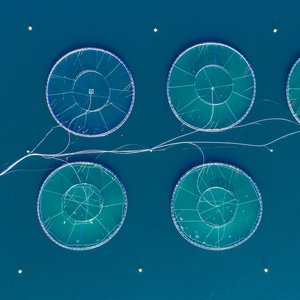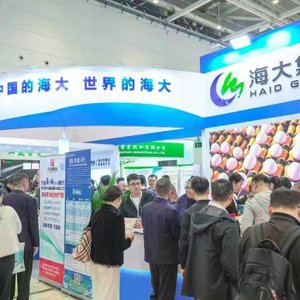Protein, fat, and carbohydrates (macronutrients) in feed, all supply energy for the fish. Energy values are expressed as either the total digestible energy (DE), metabolizable energy (ME) or net energy (NE). The NE value can be calculated from the digestible macronutrients. In contrast to DE, NE values account for the differences in the utilization efficiencies of different macronutrients, which provide the energy amount that the animal can use for growth.
“While it is common practice now in pig nutrition (and slowly making its way into poultry nutrition), it is a bit more complicated for fish. This is because we are dealing with many different species and farming (environmental) conditions. But like with other animals, using NE can help to be more precise in our formulations,” explains Johan Schrama, associate professor at the Aquaculture and Fisheries group at Wageningen University and Research (WUR) in the Netherlands.
Cooperation with industry partners
Because Schrama actively worked on NE values in swine in the 90s, he was triggered to study its potential for fish when he moved to aquaculture research years later. Between 2007-2008, Schrama started the first trials in tilapia, followed by a trout study in cooperation with the French research institute INRA (an institute that played a key role in the development of the NE system for pigs). “In 2010, we presented the results of our tilapia and trout studies at a conference in China. At the time, the interest was not there from the scientific community, yet we noticed some interest from the industry,” Schrama says. The interest accelerated in 2017 when we started our ‘NE project’, and cooperation with De Heus and Evonik on R&D and two PhD projects to determine NE calculations for a range of different fish species among others.”
Julia Mas Muñoz, global aqua product manager at De Heus Animal Nutrition, has been involved in the NE project with WUR and Evonik from the beginning. She says: “For more than ten years now, aquafeed has been an important part of our business and we have sold formulation for over 20 aqua species. When I joined the company in 2012, I was already working on raw material evaluation and creating new nutrients for aqua, as we simply didn’t have it (unlike livestock that use CVB or NRC norms). So, when Johan Schrama from WUR approached us to cooperate, it was great timing.”
Mas Muñoz sees great potential in using NE over gross nutrients (crude protein, fat, or GE) in formulations because it allows better evaluation of different (new, local) raw materials and better prediction of the outcome of a formulation on fish performance. Mas Muñoz says that “the project and PhD work also taught us, for example, that there are huge differences in the way the fish utilizes the energy from carbohydrates. The carnivore species, such as barramundi and snakehead, cannot handle carbohydrates that well. Even though they can digest them they cannot utilize them for body weight growth. Using the NE system can help us better understand what the nutrient needs are for these species.”
Continued research in tilapia and trout
In the meantime, research continues, and another two PhD projects kicked off, focused on NE application in tilapia and trout. “The research in tilapia is currently focused on the robustness of the NE equations and the effect of temperature and body weight. We know that when temperatures drop in the water, the fish uses less energy for maintenance. But what does this mean when you calculate the NE values from the digestible macronutrient values? Initial data showed that temperature had no significant effect, but body weight might have an effect on NE values, as we see that protein demand for the small fish (5-gram body weight) is much higher than heavier fish and their ability to utilize energy from protein is relatively lower. We are still investigating why this is the case,” explains Schrama.
The PhD research of Ruben Groot is done in cooperation with Alltech Coppens, where he also works as manager of quality and nutrition. His research is focusing on NE in trout, its practical application and other factors that influence energy utilization. Published data by Groot showed that a NE approach with linear efficiencies of macronutrients improved the prediction precision for growth when compared to a DE approach when evaluating feeds for rainbow trout. He also studied whether the genetic background of different strains of rainbow trout affects the relationship between digestible energy intake and retained energy. From a business perspective, Groot sees great value in using NE, because it guaranteed consistent quality between the batches, depending on the raw materials used, proving the same quality of the finished feed at all times for their clients.
Net energy system on the move
The diet of farmed fish species has been changing rapidly over the years and this, in turn, results in a change in the quantity and quality of the dietary macronutrient (such as carbohydrate and protein) composition, and the associated digestibility of the ingredients. At the same time, there has been a rapid expansion of new fish species in aquaculture, e.g., striped catfish, yellowtail kingfish and snakehead. To formulate balanced diets for these newly cultured fish species, it is necessary to understand the energy required for maintenance and growth. Not only to improve the performance and health of the animals but also from an economical and sustainability standpoint (nutrient leakage).
Schrama clearly sees a shift in the aquaculture industry in the understanding and adoption of NE. “We are not there yet, but the NE system is clearly on the move, yet it is not fully clear how many fish feed producers actually apply this way of formulation in practice,” he says.
In 2019, Alltech Coppens was among the first fish feed companies to openly state that it started to use NE formulas in aquafeed. De Heus Animal Nutrition is planning to start steering its formulations using the NE values and continues to work on norms (requirements) for NE for different species, using validation trials at their facilities in Vietnam, among others.
“An interesting next chapter would be to look into NE use in crustaceans, as this is a very big (growing) market as well. Yet, it is complicated to measure the digestion of nutrients in shrimp, and we deal with molting (and its possible effect on energy utilization). But still, more work needs to be done in the main fish species first, and WUR has built a solid foundation of research over the last decade to build upon in the coming years,” Schrama concludes.









